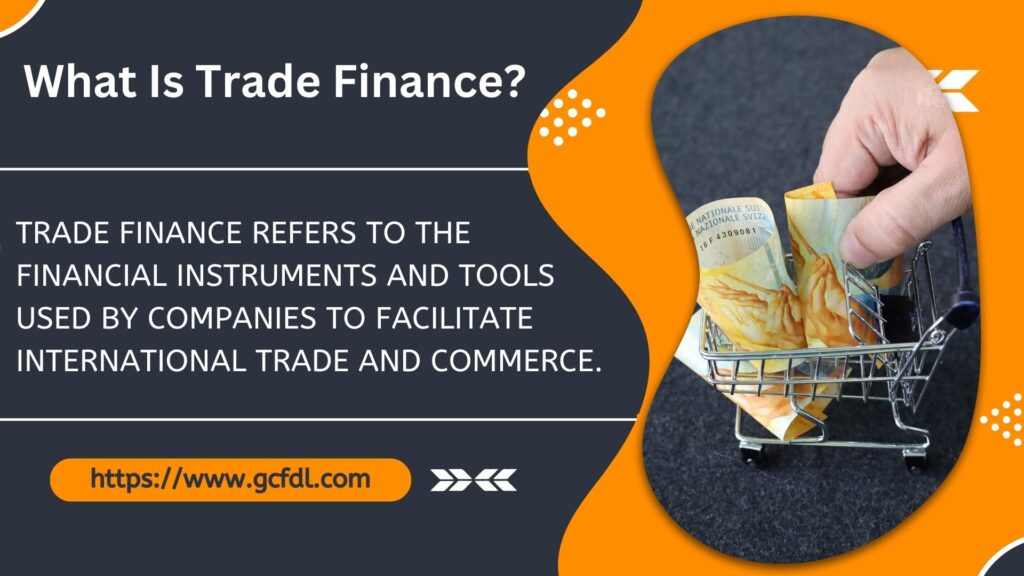Email Us Now: info@gcfdl.com
What Is Trade Finance: How It Works and Benefits
Trade finance mitigates risk associated with international trade and ensures seamless transactions between buyers and sellers.

What Is Trade Finance?
Trade finance refers to the financial instruments and tools used by companies to facilitate international trade and commerce. It plays a critical role in enabling businesses to trade goods and services across borders by bridging the gap between exporters and importers. Trade finance ensures that both parties (exporter and importer) meet their obligations while mitigating risks such as non-payment or shipment delays. Trade finance is an umbrella term meaning it covers many financial products that banks and companies utilize to make trade transactions feasible.
Parties Involved in Trade Finance
There are several key players in a trade finance transaction:
- Exporter (Seller): The party selling goods or services.
- Importer (Buyer): The party purchasing goods or services.
- Banks and Financial Institutions: Provide the financial instruments (such as loans or guarantees) to mitigate risks and ensure smooth transactions.
- Insurers: Offer trade credit insurance to reduce the risk of non-payment.
How Trade Finance Works
When conducting business outside your home country, you may encounter unfamiliar risks. These risks include not receiving payment after shipping goods, uncertainty about the creditworthiness of the company, and exposure to country-related risks such as political instability, currency exchange fluctuations, and legal complexities. Trade finance can help mitigate these risks and provide your business with a sense of security.
Trade finance involves several key instruments and products that are designed to address risks and ensure smooth trade transactions.
TYPES OF TRADE FINANCE TOOLS & PRODUCTS
- Letters of Credit (LCs): One of the most common forms of trade finance. A bank guarantees that the seller (exporter) will receive payment from the buyer (importer) once certain conditions are met, such as providing proof of shipment.
- Bills of Exchange: A written order binding one party to pay a fixed sum of money to another party on demand or at a predetermined future date. This helps exporters get paid faster.
- Export and Import Financing: Banks or financial institutions provide loans or lines of credit to cover the costs of goods or services for exporters and importers.
- Trade Credit Insurance: Protects exporters from the risk of non-payment by buyers. In case of buyer default, the insurance covers the payment.
- Factoring and Forfaiting: Factoring involves selling receivables (invoices) at a discount to a third party to accelerate cash flow. Forfaiting is a similar process but is used for long-term receivables in international trade.
- Supply Chain Financing: This involves optimizing working capital by allowing suppliers (exporters) to get paid early based on the creditworthiness of the buyer (importer).
- Documentary Collection: A bank acts as an intermediary to collect payments on behalf of the seller in exchange for shipping documents, ensuring that goods and payments are exchanged securely.
Trade Finance Process Overview
- Purchase Agreement:
- The exporter and importer enter into a contract outlining the terms of the sale, including the price, delivery schedule, payment terms, and the method of payment (e.g., letter of credit or open account).
- Trade Finance Instrument Selection:
- Based on the terms of the contract, both parties may agree on using specific trade finance instruments like a Letter of Credit (LC) or a Bill of Exchange to ensure secure payments and shipment of goods.
- Issuance of Financial Instruments:
- For Letters of Credit (LC): The buyer’s bank (issuing bank) issues an LC, guaranteeing payment to the seller once certain documents (such as proof of shipment) are provided.
- For Documentary Collection: The seller’s bank collects payments from the buyer on behalf of the seller once shipment documents are submitted.
- Goods Shipment:
- The exporter ships the goods according to the agreed terms, and prepares the necessary documents (e.g., bill of lading, invoice, certificate of origin) that serve as proof of shipment.
- Submission of Documents:
- The exporter submits the required shipping documents to their bank, which then forwards them to the buyer’s bank (or uses them in the LC process) for payment.
- Payment Processing:
- In the case of an LC, once the buyer’s bank verifies that all the conditions of the LC are met (e.g., correct documentation), it releases the payment to the seller’s bank.
- For Documentary Collection, the buyer pays once the documents are presented. Alternatively, the buyer may accept a Bill of Exchange and agree to pay at a later date (trade credit).
- Transfer of Goods:
- After the buyer’s bank approves the documents and payment is made, the buyer receives the shipping documents, which are used to take possession of the goods at the port of entry or destination.
Example of How a Letter of Credit Works
- Step 1: An importer (buyer) and exporter (seller) agree to a trade contract.
- Step 2: The importer arranges for their bank to issue a letter of credit (LC) in favor of the exporter.
- Step 3: The exporter ships the goods and presents the shipping documents (e.g., bill of lading) to their bank.
- Step 4: The exporter’s bank reviews the documents and sends them to the importer’s bank for verification.
- Step 5: The importer’s bank confirms that the documents comply with the terms of the LC and releases payment to the exporter.
- Step 6: The importer’s bank forwards the shipping documents to the importer, who can then take possession of the goods.
Real-world example of trade finance
Scenario:
General Credit Finance and Development Limited (GCFD), a financial services provider in Hong Kong, issued a Letter of Credit (LC) to facilitate a trade finance deal between PT Ambang, an Indonesian mining company, and a Chinese steel manufacturing company called ChinaSteel Ltd.
1. The Trade Agreement
- PT Ambang is an exporter of coal, a critical raw material for steel production.
- ChinaSteel Ltd., based in China, needs a steady supply of coal to meet its production demands.
- PT Ambang and ChinaSteel agree to a trade contract where PT Ambang will supply 50,000 metric tons of coal at a value of $5 million USD.
2. The Role of General Credit Finance and Development Limited (GCFD)
- To reduce risks for both the exporter (PT Ambang) and the importer (ChinaSteel Ltd.), they agree to use a Letter of Credit (LC).
- ChinaSteel Ltd. approaches General Credit Finance and Development Limited (GCFD) in Hong Kong to issue the LC on their behalf.
- GCFD issues a $5 million Letter of Credit in favor of PT Ambang, guaranteeing that payment will be made once PT Ambang ships the coal and provides the necessary shipping documents, such as the bill of lading, certificate of origin, and commercial invoice.
3. Goods Shipment and Documentation
- PT Ambang mines and prepares the 50,000 metric tons of coal as per the agreed contract.
- Once the shipment is ready, PT Ambang arranges for the coal to be transported to ChinaSteel Ltd.’s destination port in China.
- PT Ambang submits the required shipping documents (e.g., bill of lading, packing list, certificate of origin) to its bank in Indonesia.
4. Verification by General Credit Finance and Development Limited
- PT Ambang’s bank forwards the documents to General Credit Finance and Development Limited (GCFD), the issuing bank of the LC.
- General Credit Finance and Development Limited (GCFD) verifies that the documents comply with the terms of the Letter of Credit.
5. Payment to PT Ambang
- Once General Credit Finance and Development Limited (GCFD) confirms that all conditions of the LC have been met, they make a $5 million payment to PT Ambang via their bank in Indonesia.
6. ChinaSteel Ltd. Receives the Goods
- After the payment is made, ChinaSteel Ltd. receives the shipping documents from GCFD and can take possession of the coal shipment at the Chinese port.
Key Benefits in This Example:
- Risk Mitigation:
- PT Ambang (Exporter): PT Ambang was assured that they would receive payment once they shipped the goods and presented the required documents.
- ChinaSteel Ltd. (Importer): ChinaSteel Ltd. reduced the risk of paying for coal before it was shipped, as they only paid after the documents were verified by the bank.
- Role of General Credit Finance and Development Limited:
- General Credit Finance and Development Limited (GCFD) acted as an intermediary, providing confidence to both parties by issuing the Letter of Credit. This reduced the trade risk for both sides and ensured that the transaction was secure.
- Trade Expansion:
- This trade finance deal allowed PT Ambang to confidently export to ChinaSteel Ltd., knowing that the financial risk was mitigated through GCFD’s involvement. Similarly, ChinaSteel Ltd. secured a steady supply of coal without fear of pre-paying or facing shipment issues.
Benefits of Trade Finance
- Improved Cash Flow: Trade finance allows businesses to access funds sooner by facilitating quicker payments. Exporters don’t have to wait for long payment terms, and importers can receive goods before making full payment.
- Risk Mitigation: Trade finance instruments, such as LCs and credit insurance, reduce the risks of non-payment, fraud, and shipment delays, giving both buyers and sellers confidence in international transactions.
- Facilitates Global Trade: By providing credit and ensuring secure payments, trade finance allows businesses to operate in markets they might otherwise avoid due to unfamiliarity or risk.
- Better Relationships with Trading Partners: Trade finance solutions help build trust between exporters and importers by ensuring payment and delivery commitments are met.
- Flexible Payment Terms: Both buyers and sellers can negotiate favorable payment terms that suit their cash flow needs, such as deferred payments or upfront payments with extended credit.
- Enhanced Competitiveness: Businesses that use trade finance tools can expand into new markets and compete with larger firms that have better liquidity and access to financing.
- Access to Financing: Small and medium-sized enterprises (SMEs) often face challenges in accessing traditional financing. Trade finance provides alternative financing options, helping them grow and participate in international markets.
Conclusion
Trade finance is crucial for fostering global trade by reducing financial and payment risks for exporters and importers. It provides liquidity, security, and risk mitigation, allowing businesses to expand and operate efficiently in international markets.
General Credit Finance and Development Limited is a Licensed Financial Services Provider (FSP) that was incorporated in Hong Kong on APRIL 03, 1973 with company registration number 0032754.
Since our incorporation in 1973, we’ve been the trusted choice for businesses across the globe, offering tailored financial solutions such as Business Loans, SME Loans, Collateral Transfer, and Trade Finance Services, especially Standby Letters of Credit (SBLC) and Bank Guarantees (BG) issuance and monetization services.
Website: https://www.gcfdl.com || Email: info@gcfdl.com
Our website blog is a free university that can transform anyone into a world-class financial analyst. If you enjoyed this article, please share it so others can read it too.


[…] tender guarantee, often referred to as a bid bond, is a financial instrument issued by a bank or financial institution to guarantee that a bidder in a tender process will honor […]
[…] Trade finance refers to the financial tools, techniques, and instruments that banks, finance companies, and fintech providers offer to streamline international trade. It simplifies trade transactions, as well as enhancing cash flow and liquidity by offering credit facilities. This will ultimately help you expand your market reach and boost growth. […]